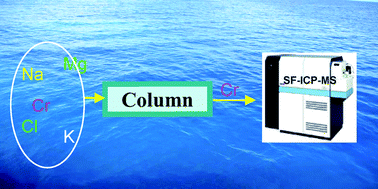An on-line matrix separation and concentration was undertaken for the direct determination of total Cr in seawater using isotope dilution with detection by sector field inductively coupled plasma mass spectrometry (ID SF-ICP-MS). A mini-column packed with 50 µl silica-immobilized diphenylcarbazone (I-DPC) resin was used to extract Cr(III) from seawater following on-line pH adjustment with a pH 9.3 solution of NH4OH/HNO3. A preliminary reduction of chromium to Cr(III) was achieved with hydroxylamine hydrochloride. Medium resolution was used to efficiently separate argon polyatomic species and any possible oxide interferences. Using a 7.5 ml volume of sample, throughput was 10 samples h−1 with a detection limit (3 s) of 0.005 ng g−1.
Method validation was demonstrated by determination of total chromium in seawater CRMs NASS-5 and CASS-4, yielding concentrations of 0.111 ± 0.011 and 0.1296 ± 0.0094 ng ml−1 (U, 95% confidence interval, k = 4.30, n = 3) in agreement with certified values. The method was applied to the determination of total Cr in candidate seawater CRMs NASS-6 and CASS-5, yielding concentrations of 0.1132 ± 0.0047 and 0.0942 ± 0.0040 ng g−1 (U, 95% confidence interval, k = 2.57, n = 6), respectively. A complete evaluation of uncertainty is presented.

You have access to this article
 Please wait while we load your content...
Something went wrong. Try again?
Please wait while we load your content...
Something went wrong. Try again?


 Please wait while we load your content...
Please wait while we load your content...